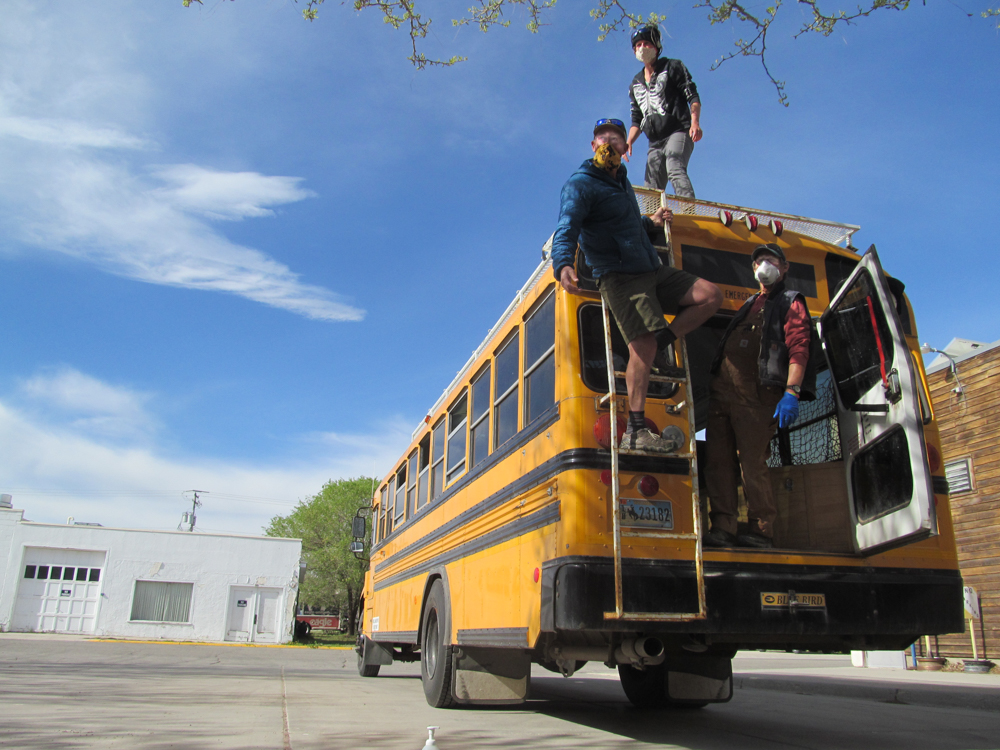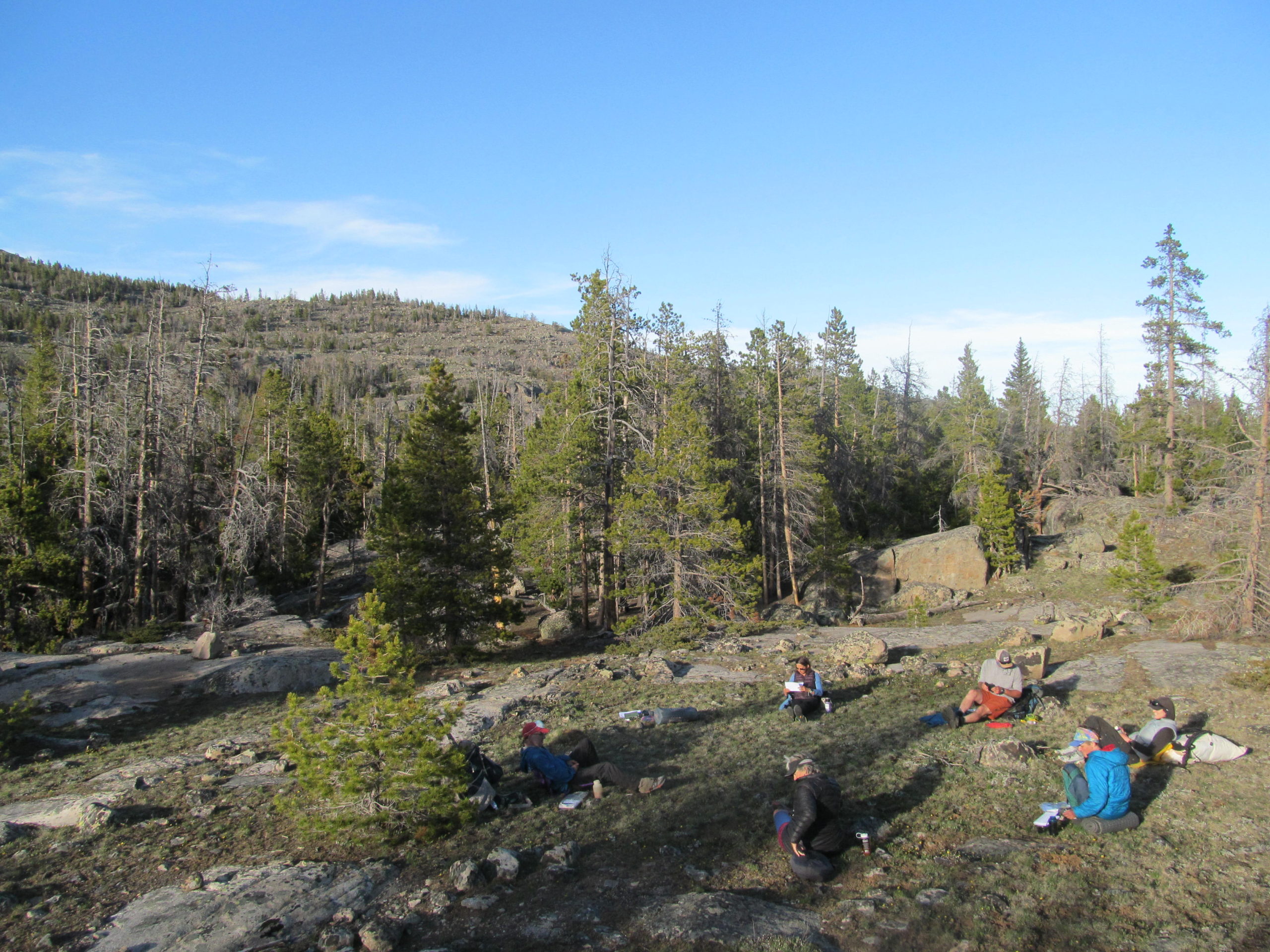From the beginning, I was skeptical. That is what drew me in; that and a desire to be involved. I read the paperwork; the .pdf described various recommended practices. We would need to implement, gauge and critique them, see how they fit into what we do.
Can we run physically distanced NOLS courses was the question. It was our job to provide the opinion from the backcountry perspective. Sunday afternoon, seven of us gathered in Lander, first via Zoom, then in person. On-line we talked backstory, goals, objectives, and expectations. We heard about the two hundred plus hours the task force had put into assessing needs (internal and external), consulting doctors, talking with others in the industry, and researching questions. Then, in person, we checked tarps, rationed food, packed packs, inspected the bear fence, and did all the other things traditionally done at the start of a NOLS course. None of us were COVID bonded; we simply went about our tasks in a conscientious and deliberate way, masks when within six feet of each other or “busy spaces” and lots of hand sanitizer.
Each of us wondered, in our own heads, what it would be like; none were overly positive. Monday evening, several miles up the runoff laden Popo Agie, we sat in a large circle painted soft by the setting sun. In that crunchy grass and wildflower covered clearing, we averaged 2.5 on a 5 scale as to if we thought what we were doing would work or be feasible.

Monday morning we loaded our packs into the back of “The Corona Express,” a big, yellow, NOLS school bus, christened by our friend and driver, Steve. We all agreed gloves were stupid, but wore them anyway as was suggested for the bus. Twenty minutes later we eased into a parking lot at the top of Sinks Canyon, shouldered our packs, took off gloves and masks, and walked into the Winds. Trekking poles at arm’s length kept us far enough from the person in front of us, but conversation never faltered as we ambled westward, climbing through fields of yellow cut leaf balsamroot, soft grey, prairie smoke, and the silky lavender of the pasque flower. Now and then we pulled off the trail, plopped our packs on the duff, filled each other’s water bottles, used liberal amounts of Purell, and dipped into our snack bags. Bright sun, dusty trails, and no snow fore told of a burning hot summer in the mountains.
Our two hiking groups rendezvoused at Sheep Bridge, the first having scouted beautiful, secluded openings among lodgepoles and glacier smoothed granite slabs; we would call it home for the evening. We split tasks and, as we occupied busy spaces, donned masks, and unpacked, sorted gear, and organized camp. The Buffs worked best for masks, normal for sun and mosquito protection on most NOLS courses anyway. Others wore tie behinds, N95s, or the ear type and we bantered back and forth regarding the efficacy of each. Cooks commandeered the kitchen, kicking everyone else out, and cheffed up cheesy fried pastas in their cook groups. With food bowls filled and served, the usual banter and chitchat of the kitchen became interspersed with the scratch of spoons on bowls and silence of people enjoying the meal. Water was put on for hot drinks and we debated the ins and outs of The COVID practices, lamenting what we did not know, what we could not google. Our debates went back and forth on kitchen practices and how to help each other out as we transitioned into the evening meeting.

Later, after closing and electrifying the bear fence, and as the evening light splayed soft lavenders and pinks on the hillsides, we strolled to our two person shelters, tarps strung between trees and trekking poles. Mosquitoes will be a problem in the coming weeks we recognized, and we brainstormed the different bug protection options available. Jackie and I entered our shelter from different ends and slowly drifted off to sleep with crickets, normal good nights, and Ursa Major views.
And so it went. For two more days we walked a loop through lodgepole and firs, meadows and forests, among lakes and creeks. We listened to chickadees, told stories, took turns cooking, asked insightful questions, and helped each other out. We donned masks when we needed to, we took them off when we could. We honed our self-awareness and looked critically at what NOLS had provided. We rummaged deep into our collective memories–side note: there was over seventeen hundred fifty field weeks between the seven of us–to think of scenarios and situations that may arise and tried to apply the principals of clean your hands often, wear masks when close or during unpredictable times (e.g. packing up or setting up camp, getting off the bus, re-rations etc.), and be conscientious and aware to them to see how they could be approached. We debated the ins and outs of group size; the difference between two and eight and three and twelve being over 25 additional feet to the circumference of a mask free group circle. Brainstorming on various skill types and operating locations allowed us to think outside the Wyoming box; collectively our varied NOLS experiences allowed for disparity in thought. We talked about the things not in our purview: evacs, in town support and logistics, doctor recommendations, how does Lander feel about it, overall route selection, course length, group size, etc.
The last evening, we hunkered from the strong cold wind that buffeted the Granite Buttress’ exposed dome. “I think it comes down to two questions” Jake reflected. “One is, `can we do this’ and the other is `should we do this’.” Six heads nodded in agreement. “Maybe we can revisit the number scale. . . I know, I know, I hate that kind of question” Jackie laughs, her smile summing up a lot of our experiences; “you know. . . that number question I asked the first night; one to five. . . will this work.” More nods of agreement. Seventeen hundred plus weeks of field experience unanimously held out all five fingers.
The bigger question though, is, should we?
We turned in with the fading daylight only to find our brand new Sea to Summit tarps slowly ripping in our first real winds. We laughed at the real time feedback, took them down, shoved the slick, silicone nylon into our packs and found hobbit holes among the trees, tucking sleeping bags into nature to protect ourselves from snow flurries and her elements.
Featured Image: Sunrise from the Granite Buttress.

If students and instructors cannot safely travel in the near and possibly long term, how about adapting and making mini classes. They could be held where the instructors are currently located and provide an opportunity for local students to get a taste of what NOLS is all about. It would be great advertisement to segments of the population who may not have heard of NOLS.
NOLS seems to have a narrow view of the “hows” of teaching. Why not try adaptive learning experiences for instructors and students of all ages and abilities. Nature is everywhere, even in cities.
OMG Mary, I am so sorry. I am not sure how I missed replying to your comment any earlier than this. Thank you for reading, thanks for visiting the blog. It seems that over the past several months NOLS has worked to adapt some of those ideas. There are instructors teaching online classes, international locations are providing more opportunities for local (instead of focusing on just bringing in N.American students), and semesters and summer courses adapted well, providing significant educational experiences to many students. It for sure has not been without its troubles and steep learning curves though! NOLS is a big ship and change doesn’t come fast, but I think that the educational models and learnings that come from pandemic operations will be held onto and continued to be adapted years into the future.
[…] To read about the ensuing camping trip click Here. […]